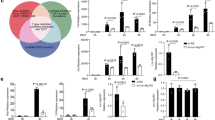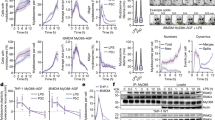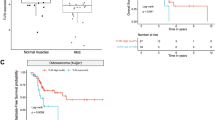Abstract
Anthracycline antibiotics are inducers of an immunogenic form of apoptosis that has immunostimulatory properties because of the release of damage-associated molecular patterns. To study the mechanisms used by the innate immune system to sense this immunogenic form of cell death, we established an in vivo model of cell death induced by intraperitoneal injection of doxorubicin, a prototype of anthracyclines. The acute sterile inflammation in this model is characterized by rapid influx of neutrophils and increased levels of IL-6 and monocyte chemotactic protein-1. We demonstrate that acute inflammation induced by doxorubicin is associated with apoptosis of monocytes/macrophages and that it is specific for doxorubicin, an immunogenic chemotherapeutic. Further, the inflammatory response is significantly reduced in mice deficient in myeloid differentiation primary response gene 88 (MyD88), TLR-2 or TLR-9. Importantly, a TLR-9 antagonist reduces the recruitment of neutrophils induced by doxorubicin. By contrast, the acute inflammatory response is not affected in TRIFLps2 mutant mice and in TLR-3, TLR-4 and caspase-1 knockout mice, which shows that the inflammasome does not have a major role in doxorubicin-induced acute inflammation. Our findings provide important new insights into how the innate immune system senses immunogenic apoptotic cells and clearly demonstrate that the TLR-2/TLR-9-MyD88 signaling pathways have a central role in initiating the acute inflammatory response to this immunogenic form of apoptosis.
Similar content being viewed by others
Log in or create a free account to read this content
Gain free access to this article, as well as selected content from this journal and more on nature.com
or
Abbreviations
- AnnV:
-
annexin V
- ATP:
-
adenosine triphosphate
- CDAM:
-
cell death-associated molecule
- CRT:
-
calreticulin
- DAMP:
-
damage-associated molecular pattern
- HMGB1:
-
high mobility group box 1 protein
- HSP:
-
heat shock protein
- i.p.:
-
intraperitoneal
- IL:
-
interleukin
- LPS:
-
lipopolysaccharide
- MCP-1:
-
monocyte chemotactic protein-1
- MSU:
-
monosodium urate
- MTC:
-
mitomycin c
- MYD88:
-
myeloid differentiation primary response gene 88
- NLR:
-
the nucleotide-binding oligomerization domain (NOD)-like receptor
- PAMP:
-
pathogen-associated molecular pattern
- PEC:
-
peritoneal exudate cell
- PRR:
-
pattern-recognition receptor
- RLR:
-
RIG-I-like receptor
- TGF-β:
-
transforming growth factor beta
- TLR:
-
Toll-like receptor
- TRIF:
-
Toll/IL-1R domain-containing adaptor inducing IFN-α
- UTP:
-
uridine triphosphate
References
Stuart LM, Lucas M, Simpson C, Lamb J, Savill J, Lacy-Hulbert A . Inhibitory effects of apoptotic cell ingestion upon endotoxin-driven myeloid dendritic cell maturation. J Immunol 2002; 168: 1627–1635.
Voll RE, Herrmann M, Roth EA, Stach C, Kalden JR, Girkontaite I . Immunosuppressive effects of apoptotic cells. Nature 1997; 390: 350–351.
Cvetanovic M, Mitchell JE, Patel V, Avner BS, Su Y, van der Saag PT et al. Specific recognition of apoptotic cells reveals a ubiquitous and unconventional innate immunity. J Biol Chem 2006; 281: 20055–20067.
Cvetanovic M, Ucker DS . Innate immune discrimination of apoptotic cells: repression of proinflammatory macrophage transcription is coupled directly to specific recognition. J Immunol 2004; 172: 880–889.
Krysko DV, Denecker G, Festjens N, Gabriels S, Parthoens E, D’Herde K et al. Macrophages use different internalization mechanisms to clear apoptotic and necrotic cells. Cell Death Differ 2006; 13: 2011–2022.
Elliott MR, Chekeni FB, Trampont PC, Lazarowski ER, Kadl A, Walk SF et al. Nucleotides released by apoptotic cells act as a find-me signal to promote phagocytic clearance. Nature 2009; 461: 282–286.
Bournazou I, Pound JD, Duffin R, Bournazos S, Melville LA, Brown SB et al. Apoptotic human cells inhibit migration of granulocytes via release of lactoferrin. J Clin Invest 2009; 119: 20–32.
Romson JL, Hook BG, Kunkel SL, Abrams GD, Schork MA, Lucchesi BR . Reduction of the extent of ischemic myocardial injury by neutrophil depletion in the dog. Circulation 1983; 67: 1016–1023.
Hall TS, Breda MA, Baumgartner WA, Borkon AM, Brawn J, Hutchins GM et al. The role of leukocyte depletion in reducing injury to the lung after hypothermic ischemia. Curr Surg 1987; 44: 137–139.
Sadasivan KK, Carden DL, Moore MB, Korthuis RJ . Neutrophil mediated microvascular injury in acute, experimental compartment syndrome. Clin Orthop Relat Res 1997; 339: 206–215.
Liu ZX, Han D, Gunawan B, Kaplowitz N . Neutrophil depletion protects against murine acetaminophen hepatotoxicity. Hepatology 2006; 43: 1220–1230.
Ghio AJ, Kennedy TP, Hatch GE, Tepper JS . Reduction of neutrophil influx diminishes lung injury and mortality following phosgene inhalation. J Appl Physiol 1991; 71: 657–665.
Apetoh L, Ghiringhelli F, Tesniere A, Obeid M, Ortiz C, Criollo A et al. Toll-like receptor 4-dependent contribution of the immune system to anticancer chemotherapy and radiotherapy. Nat Med 2007; 13: 1050–1059.
Casares N, Pequignot MO, Tesniere A, Ghiringhelli F, Roux S, Chaput N et al. Caspase-dependent immunogenicity of doxorubicin-induced tumor cell death. J Exp Med 2005; 202: 1691–1701.
Matzinger P . The danger model: a renewed sense of self. Science 2002; 296: 301–305.
Zitvogel L, Kepp O, Kroemer G . Decoding cell death signals in inflammation and immunity. Cell 2010; 140: 798–804.
Obeid M, Tesniere A, Ghiringhelli F, Fimia GM, Apetoh L, Perfettini JL et al. Calreticulin exposure dictates the immunogenicity of cancer cell death. Nat Med 2007; 13: 54–61.
Kono H, Rock KL . How dying cells alert the immune system to danger. Nat Rev Immunol 2008; 8: 279–289.
Hoebe K, Du X, Georgel P, Janssen E, Tabeta K, Kim SO et al. Identification of Lps2 as a key transducer of MyD88-independent TIR signalling. Nature 2003; 424: 743–748.
Krysko DV, Vanden Berghe T, D’Herde K, Vandenabeele P . Apoptosis and necrosis: detection, discrimination and phagocytosis. Methods 2008; 44: 205–221.
Krysko DV, Vanden Berghe T, Parthoens E, D’Herde K, Vandenabeele P . Methods for distinguishing apoptotic from necrotic cells and measuring their clearance. Methods Enzymol 2008; 442: 307–341.
Chen CJ, Shi Y, Hearn A, Fitzgerald K, Golenbock D, Reed G et al. MyD88-dependent IL-1 receptor signaling is essential for gouty inflammation stimulated by monosodium urate crystals. J Clin Invest 2006; 116: 2262–2271.
Martinon F, Mayor A, Tschopp J . The inflammasomes: guardians of the body. Annu Rev Immunol 2009; 27: 229–265.
Ghiringhelli F, Apetoh L, Tesniere A, Aymeric L, Ma Y, Ortiz C et al. Activation of the NLRP3 inflammasome in dendritic cells induces IL-1beta-dependent adaptive immunity against tumors. Nat Med 2009; 15: 1170–1178.
Park JS, Svetkauskaite D, He Q, Kim JY, Strassheim D, Ishizaka A et al. Involvement of Toll-like receptors 2 and 4 in cellular activation by high mobility group box 1 protein. J Biol Chem 2004; 279: 7370–7377.
Urbonaviciute V, Furnrohr BG, Meister S, Munoz L, Heyder P, De Marchis F et al. Induction of inflammatory and immune responses by HMGB1-nucleosome complexes: implications for the pathogenesis of SLE. J Exp Med 2008; 205: 3007–3018.
Tian J, Avalos AM, Mao SY, Chen B, Senthil K, Wu H et al. Toll-like receptor 9-dependent activation by DNA-containing immune complexes is mediated by HMGB1 and RAGE. Nat Immunol 2007; 8: 487–496.
Ivanov S, Dragoi AM, Wang X, Dallacosta C, Louten J, Musco G et al. A novel role for HMGB1 in TLR9-mediated inflammatory responses to CpG-DNA. Blood 2007; 110: 1970–1981.
Kroemer G, Galluzzi L, Vandenabeele P, Abrams J, Alnemri ES, Baehrecke EH et al. Classification of cell death: recommendations of the Nomenclature Committee on Cell Death 2009. Cell Death Differ 2009; 16: 3–11.
Krysko DV, D’Herde K, Vandenabeele P . Clearance of apoptotic and necrotic cells and its immunological consequences. Apoptosis 2006; 11: 1709–1726.
Bellarosa D, Ciucci A, Bullo A, Nardelli F, Manzini S, Maggi CA et al. Apoptotic events in a human ovarian cancer cell line exposed to anthracyclines. J Pharmacol Exp Ther 2001; 296: 276–283.
Tanaka H, Matsushima H, Mizumoto N, Takashima A . Classification of chemotherapeutic agents based on their differential in vitro effects on dendritic cells. Cancer Res 2009; 69: 6978–6986.
Chen CJ, Kono H, Golenbock D, Reed G, Akira S, Rock KL . Identification of a key pathway required for the sterile inflammatory response triggered by dying cells. Nat Med 2007; 13: 851–856.
Eigenbrod T, Park JH, Harder J, Iwakura Y, Nunez G . Cutting edge: critical role for mesothelial cells in necrosis-induced inflammation through the recognition of IL-1 alpha released from dying cells. J Immunol 2008; 181: 8194–8198.
Cavassani KA, Ishii M, Wen H, Schaller MA, Lincoln PM, Lukacs NW et al. TLR3 is an endogenous sensor of tissue necrosis during acute inflammatory events. J Exp Med 2008; 205: 2609–2621.
Garg AD, Nowis D, Golab J, Vandenabeele P, Krysko DV, Agostinis P . Immunogenic cell death, DAMPs and anticancer therapeutics: an emerging amalgamation. Biochim Biophys Acta 2010; 1805: 53–71.
Chase MA, Wheeler DS, Lierl KM, Hughes VS, Wong HR, Page K . Hsp72 induces inflammation and regulates cytokine production in airway epithelium through a TLR4- and NF-kappaB-dependent mechanism. J Immunol 2007; 179: 6318–6324.
Wheeler DS, Chase MA, Senft AP, Poynter SE, Wong HR, Page K . Extracellular Hsp72, an endogenous DAMP, is released by virally infected airway epithelial cells and activates neutrophils via Toll-like receptor (TLR)-4. Respir Res 2009; 10: 31.
Scaffidi P, Misteli T, Bianchi ME . Release of chromatin protein HMGB1 by necrotic cells triggers inflammation. Nature 2002; 418: 191–195.
Dasari P, Nicholson IC, Hodge G, Dandie GW, Zola H . Expression of Toll-like receptors on B lymphocytes. Cell Immunol 2005; 236: 140–145.
Acknowledgements
We thank Professor S Akira (for TLR-4−/− mice), Professor B Beutler (for TRIFLps2 mice), Professor G Lauvau (for Myd88−/− mice), Professor R Beyaert and J Maelfait (for TLR-3−/− mice). This work was supported by the Fund for Scientific Research Flanders (FWO-Vlaanderen, 3G072810 to D.V.K.) and by an individual research grant from FWO-Vlaanderen (31507110 to D.V.K). D.V.K is a postdoctoral fellow and AK is a doctoral fellow, both paid by fellowships from FWO-Vlaanderen. Research in the Vandenabeele unit has been supported by Flanders Institute for Biotechnology (VIB), by European grants (FP6 ApopTrain, MRTN-CT-035624; FP7 EC RTD Integrated Project, Apo-Sys, FP7-200767; Euregional PACT II), Belgian grants (Interuniversity Attraction Poles, IAP 6/18) Flemish grants (Fonds Wetenschappelijke Onderzoek Vlaanderen, G.0875.11 and G.0973.11), and Ghent University grants (MRP, GROUP-ID). PV is holder of a Methusalem grant (BOF09/01M00709) from the Flemish Government. We thank Dr. Amin Bredan (DMBR-VIB, Ghent) for editing the paper.
Author information
Authors and Affiliations
Corresponding author
Ethics declarations
Competing interests
The authors declare no conflict of interest.
Additional information
Edited by P Mehlen
Rights and permissions
About this article
Cite this article
Krysko, D., Kaczmarek, A., Krysko, O. et al. TLR-2 and TLR-9 are sensors of apoptosis in a mouse model of doxorubicin-induced acute inflammation. Cell Death Differ 18, 1316–1325 (2011). https://doi.org/10.1038/cdd.2011.4
Received:
Revised:
Accepted:
Published:
Issue date:
DOI: https://doi.org/10.1038/cdd.2011.4
Keywords
This article is cited by
-
RGS7 balances acetylation/de-acetylation of p65 to control chemotherapy-dependent cardiac inflammation
Cellular and Molecular Life Sciences (2023)
-
E-cig vapor condensate alters proteome and lipid profiles of membrane rafts: impact on inflammatory responses in A549 cells
Cell Biology and Toxicology (2021)
-
Toll-like receptor 9 negatively related to clinical outcome of AML patients
Journal of the Egyptian National Cancer Institute (2020)
-
Doxorubicin increases permeability of murine small intestinal epithelium and cultured T84 monolayers
Scientific Reports (2020)
-
Ferroptosis at the crossroads of cancer-acquired drug resistance and immune evasion
Nature Reviews Cancer (2019)



